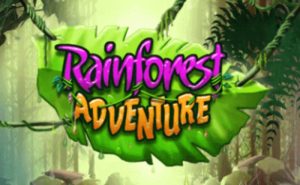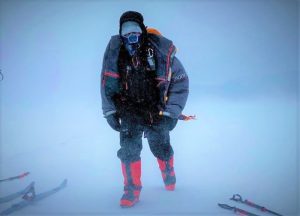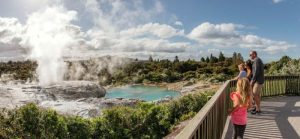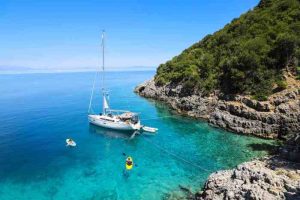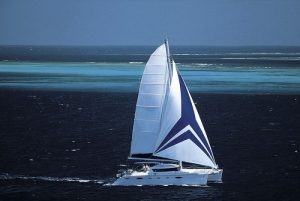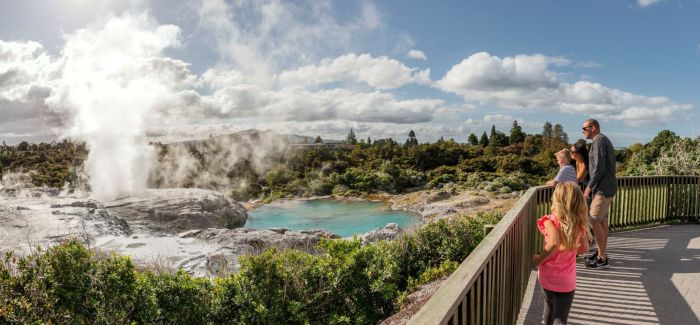
New Zealand’s dramatic landscapes, sculpted by millions of years of geological activity, offer unparalleled opportunities for exploration. From the towering peaks of the Southern Alps to the mesmerizing glowworm caves of Waitomo, the country is a geological wonderland. This guide delves into the diverse range of geological tours available, catering to adventurers of all levels, and highlights the planning essentials for an unforgettable experience.
Whether you’re captivated by active volcanoes, intrigued by ancient cave systems, or fascinated by the forces that shaped this unique landmass, a geological tour of New Zealand promises a journey of discovery. We’ll explore the various tour types, itineraries, and essential considerations to help you plan your own immersive adventure through New Zealand’s remarkable geological history.
Geological Wonders of New Zealand

New Zealand’s dramatic landscapes are a testament to millions of years of intense geological activity. The country’s location at the boundary of the Australian and Pacific tectonic plates has resulted in a breathtaking array of geological formations, from towering volcanoes and dramatic fiords to extensive cave systems and stunning beaches. This unique geological history is readily accessible, offering unparalleled opportunities for exploration and discovery.
Diverse Geological Formations in New Zealand
New Zealand boasts a remarkable diversity of geological features. The country’s volcanic activity, particularly in the North Island, has created geothermal areas like Rotorua, with its bubbling mud pools and geysers, and the dramatic volcanic cones of the Taupo Volcanic Zone. In contrast, the South Island showcases the power of glacial erosion, with deep fiords carved into the landscape, such as Milford Sound and Doubtful Sound in Fiordland National Park.
Extensive cave systems, like the Waitomo Caves, reveal fascinating subterranean formations and unique ecosystems. Coastal areas exhibit diverse landforms shaped by powerful ocean currents and erosion, from the dramatic cliffs of the West Coast to the sandy beaches of the Bay of Islands. These diverse formations are a result of a complex interplay of tectonic activity, volcanic eruptions, glacial carving, and coastal processes.
Geological Processes Shaping New Zealand’s Landscape
The collision of the Australian and Pacific plates is the primary driver of New Zealand’s geological dynamism. This plate boundary, running down the length of the country, is responsible for earthquakes, volcanic eruptions, and the uplift of mountain ranges. Millions of years of subduction – where one plate slides beneath another – have created the volcanic arcs of the North Island and contributed to the formation of the Southern Alps.
Glacial activity, particularly during past ice ages, dramatically shaped the South Island’s landscape, carving deep valleys and leaving behind distinctive U-shaped valleys and moraines. Coastal erosion continues to reshape the coastline, creating dramatic cliffs, beaches, and estuaries. The interplay of these processes has resulted in the constantly evolving and breathtaking landscapes seen today.
Significant Geological Sites for Tours
Several geological sites in New Zealand offer exceptional opportunities for guided tours. Milford Sound, accessible by road and boat, showcases the grandeur of glacial erosion with its towering cliffs, cascading waterfalls, and pristine waters. The Waitomo Caves, easily accessible via guided tours, reveal a spectacular underworld of glowworm grottos and intricate cave formations. Rotorua, easily accessible by road, provides a unique experience with its geothermal wonders, including geysers, mud pools, and hot springs.
These sites offer varying levels of accessibility, catering to a wide range of visitor preferences and physical capabilities. Each site provides a unique perspective on New Zealand’s geological history and the processes that shaped its landscape.
Comparison of Geological Regions
| Region | Key Features | Accessibility | Tour Options |
|---|---|---|---|
| Fiordland National Park | Deeply carved fiords, towering mountains, waterfalls, temperate rainforest | Accessible by road and boat; some areas require hiking | Cruises, hiking, kayaking, scenic flights |
| Taupo Volcanic Zone | Active and dormant volcanoes, geothermal areas, geysers, hot springs, lakes | Excellent road access; some areas require walking | Guided tours of geothermal areas, hiking, scenic drives |
| Waitomo Caves | Extensive cave systems, glowworm grottos, stalactites, stalagmites | Easy road access; guided cave tours available | Guided cave tours, black water rafting |
Types of Geological Tours Available
New Zealand’s diverse geology offers a wide array of tour options catering to various interests and experience levels. From gentle strolls through geothermal areas to challenging multi-day hikes across active volcanic landscapes, there’s a geological adventure waiting for everyone. The tours are carefully designed to balance accessibility with the thrill of exploring New Zealand’s unique geological formations.
Guided Walks and Nature Tours
These tours typically focus on easily accessible locations showcasing significant geological features. They are ideal for families, less experienced hikers, and those who prefer a more relaxed pace. A typical itinerary might involve a 2-4 hour walk through a national park, visiting significant geological sites like a canyon, waterfall, or unique rock formations. The difficulty level is generally low to moderate, and the included activities might include informative talks from expert guides, opportunities for photography, and perhaps a picnic lunch.
Price ranges are generally affordable, starting from around NZD $80 per person.
Cave Explorations
New Zealand boasts a remarkable network of caves, some featuring impressive stalactite and stalagmite formations, others showcasing ancient geological processes. Cave exploration tours vary in intensity, from guided walks through well-lit and easily accessible caves to more adventurous caving experiences involving ropes and specialized equipment. A typical itinerary for a basic cave tour might involve a 2-3 hour guided walk through a show cave, while more advanced tours could last a full day and involve physically demanding activities.
The price range reflects the level of difficulty and expertise required, with basic tours starting around NZD $100 per person and more adventurous options reaching NZD $300 or more. The target audience spans from families to adventurous thrill-seekers.
Volcano Hikes and Geothermal Tours
These tours offer a chance to witness firsthand the power of New Zealand’s volcanic activity. They range from gentle walks around dormant volcanoes to challenging hikes up active ones. A typical itinerary might involve a 4-6 hour hike to a volcanic crater, with the opportunity to observe geothermal features such as geysers and hot springs. Difficulty levels vary greatly depending on the chosen volcano and the route taken.
Prices range from NZD $120 for less strenuous hikes to over NZD $250 for multi-day expeditions requiring specialized gear and guides. The target audience includes those with a strong interest in volcanology and those who enjoy more physically challenging activities.
Seven-Day South Island Geological Tour Itinerary: A Sample
This itinerary focuses on a diverse range of geological features across the South Island, combining various tour types and difficulty levels.
| Day | Location | Activity | Difficulty |
|---|---|---|---|
| 1 | Abel Tasman National Park | Guided walk through coastal sandstone formations | Easy |
| 2 | Punakaiki Pancake Rocks | Coastal walk observing unique rock formations | Easy to Moderate |
| 3 | Hokitika Gorge | Short walk to the gorge, admiring turquoise waters | Easy |
| 4 | Franz Josef or Fox Glacier | Guided glacier hike (various options available) | Moderate to Strenuous (depending on chosen hike) |
| 5 | Mount Cook National Park | Hike to a viewpoint offering panoramic views of the Southern Alps | Moderate |
| 6 | Queenstown area | Optional activities: short hikes, gondola rides with geological viewpoints | Easy to Moderate |
| 7 | Waipara Valley | Visit vineyards and learn about the geological influence on viticulture | Easy |
Note: This is a sample itinerary, and specific activities and difficulty levels can be adjusted based on individual preferences and fitness levels. Accommodation and transportation would need to be arranged separately. Prices will vary significantly depending on chosen accommodation, transportation, and specific tour options selected for each day.
Planning a Geological Tour in New Zealand
Embarking on a geological tour of New Zealand requires careful planning to ensure a safe, enjoyable, and enriching experience. This involves several key steps, from selecting the right tour operator to considering personal fitness and packing appropriate gear. Thorough preparation will maximize your appreciation of New Zealand’s stunning geological landscapes.
Choosing a Tour Operator and Booking
Selecting a reputable tour operator is crucial. Consider their experience, specialization in geological tours, and client reviews. Look for operators who provide detailed itineraries, clear pricing, and excellent customer service. Booking well in advance, especially during peak season, is recommended to secure your preferred dates and potentially benefit from early-bird discounts. Many operators offer various tour lengths and focuses, catering to different interests and experience levels.
For example, some might specialize in specific regions like Fiordland or the volcanic plateau, while others offer broader, multi-region tours. It’s important to carefully read the tour descriptions and compare offerings to find the best fit for your preferences and budget.
Essential Considerations: Fitness, Weather, and Equipment
New Zealand’s geological landscapes often involve varying degrees of physical exertion. Hiking, climbing, and traversing uneven terrain are common. Assessing your fitness level beforehand is vital. Choose a tour that aligns with your capabilities, and don’t hesitate to contact the operator to discuss any concerns. New Zealand’s weather is notoriously unpredictable.
Be prepared for sudden changes, including rain, wind, and temperature fluctuations. Packing layers of clothing is essential. Appropriate footwear is crucial for safety and comfort on various terrains. Sturdy hiking boots with good ankle support are highly recommended. Other essential equipment includes a waterproof jacket, sunscreen, insect repellent, and a hat.
Reputable Tour Operators
Several reputable tour operators specialize in geological tours in New Zealand. While specific strengths and weaknesses can vary depending on individual experiences and preferences, some well-regarded operators often cited include:
- Example Operator A: Known for their comprehensive itineraries covering a wide range of geological sites across the South Island. A potential weakness might be larger group sizes, leading to less personalized attention.
- Example Operator B: Specializes in smaller, more intimate group tours, often focusing on specific geological features like glaciers or geothermal areas. This might mean a higher price point compared to larger tour groups.
- Example Operator C: Offers a diverse range of tours, including guided hikes and more adventurous options like rock climbing or caving. This wider range might mean a less specialized approach to geological explanations compared to more focused operators.
Note: This is not an exhaustive list, and the strengths and weaknesses of each operator are subjective and based on general feedback. Independent research is always recommended.
Packing Checklist
Preparing a comprehensive packing list ensures you’re well-equipped for your geological adventure.
Clothing
- Moisture-wicking base layers
- Insulating mid-layers (fleece or down jacket)
- Waterproof and windproof outer shell
- Hiking trousers or shorts
- Warm socks (wool or synthetic)
- Hat and gloves
Gear
- Sturdy hiking boots
- Backpack (appropriate size for the tour)
- Walking poles (optional, but recommended for stability)
- Headlamp or flashlight
- Binoculars (for wildlife and landscape viewing)
- Camera and extra batteries
Essentials
- Sunscreen and lip balm
- Insect repellent
- First-aid kit
- Water bottle or hydration pack
- Snacks (energy bars, trail mix)
- Map and compass (or GPS device)
- Copies of important documents (passport, travel insurance)
New Zealand’s Geological Significance in a Broader Context
New Zealand’s geological story is a compelling narrative of plate tectonics, volcanic activity, and the resulting unique biodiversity. Its position at the boundary of the Australian and Pacific plates makes it a globally significant location for understanding these powerful geological processes, offering unparalleled insights into Earth’s dynamic systems and their influence on life. The country’s geological history is intricately woven into its cultural heritage and provides a framework for understanding its present-day ecosystems.New Zealand’s geological importance in understanding plate tectonics and volcanic activity is undeniable.
The country sits astride the boundary of two major tectonic plates, resulting in intense seismic and volcanic activity. The collision and subduction of these plates have created a landscape characterized by dramatic mountain ranges, active volcanoes, geothermal areas, and frequent earthquakes. This active geological setting provides a living laboratory for scientists to study plate boundary processes, volcanic eruption mechanisms, and the long-term effects of tectonic forces on the Earth’s crust.
The readily observable evidence of plate movement and volcanic activity allows for direct observation and analysis of geological processes that are often obscured in other parts of the world. For instance, the Taupo Volcanic Zone, a highly active geothermal region, provides crucial data on magma dynamics and hydrothermal systems.
Comparison of New Zealand’s Geological Features with Other Regions
New Zealand’s geological features offer a unique combination of characteristics not found in many other places globally. While volcanic activity is observed in regions like the Ring of Fire (encircling the Pacific Ocean), New Zealand’s specific combination of subduction-related volcanism, transform faulting, and the uplift of ancient rock formations is relatively rare. The dramatic fiords of Fiordland National Park, carved by glaciers during past ice ages, are comparable to those found in Norway and Chile, highlighting the global impact of glacial processes.
However, the combination of these features, along with the unique flora and fauna adapted to them, distinguishes New Zealand’s geological landscape. The scale of the Southern Alps, formed by the collision of the Australian and Pacific plates, is comparable to other major mountain ranges formed by continental collisions, but the relatively young age of these mountains provides a distinct focus for geological study.
Influence of New Zealand’s Geological History on Biodiversity and Ecosystems
New Zealand’s geological history has profoundly shaped its unique biodiversity. The long period of isolation, coupled with the diverse geological environments created by tectonic activity and volcanism, has resulted in the evolution of many endemic species found nowhere else on Earth. Volcanic soils, for example, support unique plant communities adapted to nutrient-rich but often unstable environments. The varied topography, from alpine peaks to coastal plains, has created a range of habitats supporting a rich diversity of life.
The geological history also plays a crucial role in shaping the distribution of these species, with isolated mountain ranges acting as refugia for endemic populations. The ongoing geological processes continue to influence ecosystem dynamics, with volcanic eruptions and earthquakes altering landscapes and creating new opportunities for species to colonize and adapt.
Relationship Between New Zealand’s Geology and Cultural Heritage
New Zealand’s Māori culture is deeply intertwined with its geological landscape. Māori oral traditions, passed down through generations, incorporate detailed knowledge of geological features, their formation, and their significance to the land. Many significant sites for Māori culture are directly linked to specific geological formations, reflecting a deep understanding of the land’s history and its resources. Volcanic landscapes, geothermal areas, and significant rock formations often feature prominently in Māori mythology and storytelling, highlighting the spiritual and cultural connection between the people and the geology.
The use of volcanic rock for tools and building materials further demonstrates the practical integration of geology into Māori life. This profound connection between geology and cultural heritage showcases the importance of understanding the geological context when exploring New Zealand’s cultural landscape.
Related Travel Experiences in New Zealand
New Zealand’s diverse landscape offers a wealth of travel experiences beyond its geological wonders. Many activities seamlessly integrate with geological tours, enhancing the overall travel experience and providing a more holistic understanding of the country’s natural beauty and unique characteristics. The following sections explore these complementary travel options.
Geological Tours and Adventure Sports Travel
The dramatic landscapes sculpted by New Zealand’s geological forces provide the perfect backdrop for a range of adventure sports. The rugged mountains, pristine fiords, and dramatic coastlines offer opportunities for activities such as hiking, kayaking, white-water rafting, and bungee jumping. For instance, a geological tour exploring the Fiordland National Park could easily incorporate a kayaking trip through Milford Sound, allowing participants to appreciate the towering cliffs and waterfalls from a unique perspective.
Similarly, a tour focusing on the volcanic activity of Rotorua could include a thrilling mountain biking experience through the volcanic terrain. These combined experiences offer a dynamic blend of geological learning and adrenaline-pumping adventure.
Geological Tours and Birdwatching Tours
New Zealand’s unique avifauna is closely tied to its geology. Many endemic bird species inhabit specific geological formations or ecosystems. A geological tour of the West Coast, for example, could be enhanced by including visits to areas known for kiwi sightings, given the relationship between kiwi habitat and the region’s unique geological features. Similarly, a tour focusing on the volcanic landscapes of the North Island could incorporate visits to areas known for native bird populations thriving in these specific habitats.
The combination provides a richer understanding of the interconnectedness of geological processes and biodiversity. Locations such as the Zealandia Ecosanctuary in Wellington combine both geological and ornithological interests in a controlled environment.
Combining Geological Tours with Other Travel Interests
The versatility of New Zealand’s geography allows for the seamless integration of geological tours with a variety of other travel interests. A geological tour of Marlborough Sounds could be combined with a sailing trip, allowing for exploration of the region’s intricate coastline and its geological formation from the water. Golf enthusiasts could combine a tour of the geothermal regions with rounds of golf on courses with stunning volcanic backdrops.
Wellness retreats could incorporate geological hikes and spa treatments, offering a rejuvenating experience in a naturally beautiful setting.
Potential Travel Combinations
The following list demonstrates the potential for combining geological tours with other travel interests in New Zealand.
- Geological Tour of Fiordland National Park + Adventure Sports Travel (Kayaking, Hiking): Explore the dramatic fiords and mountains, combining geological insights with thrilling outdoor activities.
- Geological Tour of the West Coast + Birdwatching Tours: Discover the region’s geological history and observe its unique birdlife, including the elusive kiwi.
- Geological Tour of Rotorua + Adventure Sports Travel (Mountain Biking): Experience the geothermal wonders and challenge yourself with exhilarating mountain biking through volcanic landscapes.
- Geological Tour of Marlborough Sounds + Sailing and Yachting: Explore the stunning coastline from both land and sea, gaining a comprehensive understanding of the region’s geology.
- Geological Tour of Central Otago + Golf Vacations: Combine the beauty of Central Otago’s geological formations with world-class golf courses nestled in stunning landscapes.
- Geological Tour of the Southern Alps + Wellness Cruises: Experience the grandeur of the Southern Alps while enjoying rejuvenating wellness activities on a scenic cruise.
Closing Summary

Embarking on a geological tour in New Zealand is more than just sightseeing; it’s a journey through deep time, witnessing firsthand the immense power of nature. From the dramatic fiords to the geothermal wonders, each location unveils a story etched in rock, offering a profound connection to the planet’s dynamic processes. With careful planning and the right tour operator, your New Zealand geological adventure will be both educational and awe-inspiring, leaving you with memories to last a lifetime.
FAQ Explained
What’s the best time of year to visit for geological tours?
New Zealand’s weather varies regionally. Summer (November-March) offers warmer temperatures but can be busy. Spring (September-November) and Autumn (March-May) offer pleasant weather with fewer crowds.
Are geological tours suitable for families with children?
Many tours cater to families, offering easier walks and age-appropriate activities. Choose tours with clearly stated difficulty levels and ensure they align with your children’s abilities.
What level of fitness is required for these tours?
Fitness levels vary greatly depending on the chosen tour. Some are gentle walks, while others involve strenuous hikes. Carefully review tour descriptions and choose one that matches your fitness capabilities.
How much do geological tours typically cost?
Prices vary significantly based on duration, location, and inclusions. Expect to pay from a few hundred to several thousand dollars per person, depending on the tour.
